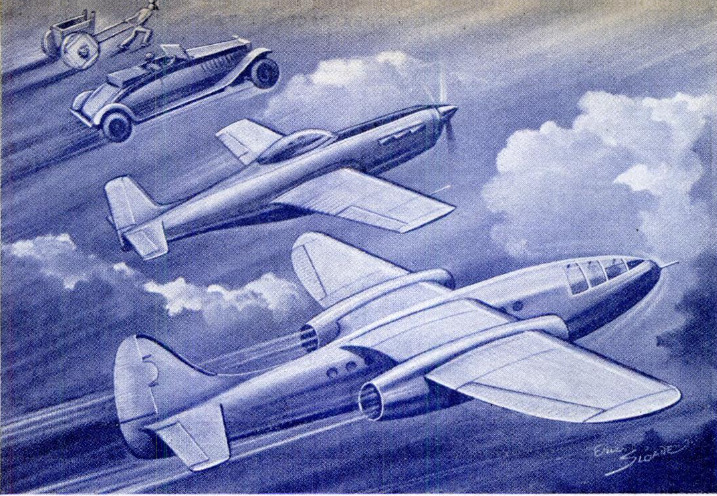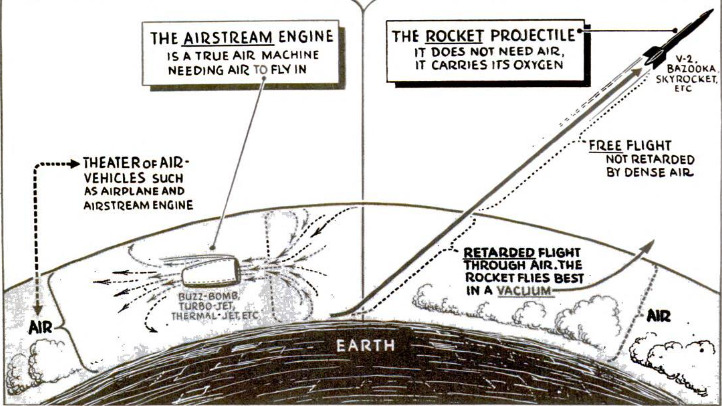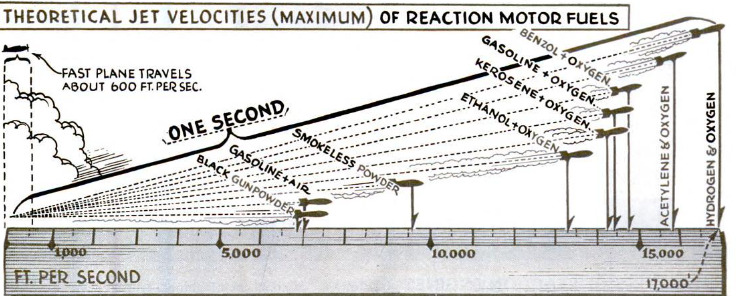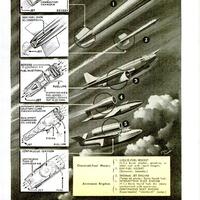-
Title (Dublin Core)
-
The reaction engine
-
Article Title and/or Image Caption (Dublin Core)
-
The reaction engine
-
extracted text (Extract Text)
-
THE V-2 bombs exploding in England be-
fore they could be heard coming, the U. S.
Navy's little zoom boats blanketing Japs
with blast, and the U. S. Army's Shooting
Star, jet-propelled fighter, outflying every
other plane in the air have demonstrated
anew a law formulated about 265 years ago
by an Englishman who is said to have been
conked on the head by a falling apple.
Sir Isaac Newton pointed out three laws
of motion. The first is that bodies of matter
do not alter their motion except as the result
of forces applied to them. The second ex-
plains the relation of such forces to momen-
tum and direction. And the third is: “To
every action there is always an equal and
contrary reaction; the mutual actions of
any two bodies are always equal and oppo-
sitely directed.”
The first two laws cover the motions of
both an oxcart and a B-29. Men looking for
action have tended throughout history to
neglect the reaction, or to use it only in-
cidentally. But the creators of new weapons
of war have found now that, because of
Newton's third law, it often pays to throw
away the action and use the reaction. That
is the secret of rocket power.
For good or ill, the inventors’ new appre-
ciation of this old fact of dynamics is cer-
tain now to bring about changes that will
affect the life of every person in the world.
The purpose of an engine is to change
the chemical energy of a fuel into some
useful mechanical mofion. Steam and gaso-
line engines convert the energy of coal or
oil into rotary motion. We must familiarize
ourselves now, however, with an entirely
new kind of engine. It uses chemical energy
but, instead of rotary motion, it produces
a straight, powerful thrust. It has no cams,
gears, pistons, crankshafts, or connecting
rods, and need not be attached to wheels or
a propeller, because it does not “roll”; it
just “goes,” and whatever is attached to it
goes along.
Such an engine is a reaction motor. It is
thrust forward by the reaction to the action
of a jet of gas. Hence, the principle of the
reaction motor is known as jet propulsion.
People often presume that the jet drives
a rocket forward by pushing against the
air. That is impossible. Gas consists of bil-
lions of pellets, or molecules, that are not
connected in any way. They tend, in fact,
to dart away from each other as fast as
possible. The air also consists of random,
flying molecules. When a molecule of gas
bumps into a molecule of air, both go off
in different directions with altered speed.
But how could even thousands of billions
of such collisions between loose molecules
drive a rocket that is not connected to them
—drive it, moreover, in a specific direction?
A stream of gas, no matter how fast it
moves or how dense it may be, is not a solid
connecting rod capable of pushing against
something and transmitting the push back
against whatever is adjacent to its other
end. So you could no more move a plane by
pressing against the air with a jet of gas
than you could row a boat with a liquid
oar.
The air is a resisting medium. It inter-
feres with both the escape of the gas from
a rocket and the forward motion of the
rocket, but it does mot help drive the
rocket. The thrust is the reaction to the
ejection of the gas.
Lest this still not be clear, suppose that
a lot of gas were locked in a box. The pres-
sure of the gas would be the same against
all sides of the container, 0 the box would
not move. But, if a hole were cut in the left
side, the gas would rush out. The pressure
on the left side of the box would then be less
than the pressure on the right side, so the
box would jump to the right.
Both the gas and the box would be re-
tarded by the atmosphere. But, if not re-
tarded in any way, a light box could move
as fast as the gas.
By putting a nozzle in the hole, to direct
and control the expansion of the gas, the
speed of the jet and the box might be in-
creased. Then, if arrangements were added
to replenish the supply of gas, the box would
be a crude reaction motor. Replenishing the
gas, however, would require fuel.
One of the most common—and mistaken
—notions about rocket power is that the
fuel question is the principal obstacle to its
further development. Nothing could be
farther from the truth. Reaction motors
need no special fuels. Research, of course,
will undoubtedly result in the discovery of
better fuels and better combinations of fuels,
but the fuels needed for the coming age of
rocket power are already at hand.
Reaction motors will run on kerosene,
gasoline, or alcohol; on gunpowder, pow-
dered metal, or coal dust dissolved in oil; or
any of a long list of other compounds. A
fuel is simply something from which the
motor can extract energy,
Directly or indirectly, all the energy on
the earth, except that from radioactive ma-
terials, has come from the sun. Energy has
been stored in the molecules of certain
chemical compounds by endothermic, or
heat-absorbing, reactions. It can be released
by exothermic, or heat-releasing, reactions.
When this is done at exactly the right time,
place, and rate, a jet is produced.
But oxygen is needed to bring about
exothermic reactions, and reaction motors
are classified according to the way the
oxygen is obtained. It may be fed to the
motor in chemical compounds, in the mole-
cules of the fuel itself, or in a compressed
and liquefied form after having been sepa-
rated from the other gases of the air. When
the oxgyen is supplied in any of these ways,
the reaction motor is called a self-contained,
or chemical-fuel, motor.
About a fifth of the earth's atmosphere
is oxygen, so it is possible also to bring
about the desired combustion of fuel by
simply using air, and when this is done the
reaction motor is called an airstream on-
gine. To discuss rocket power intelligently
with an engineer, you must remember the
difference between chemical-fuel motors
and airstream engines,
A chemical-fuel motor may use either a
dry or a liquid fuel. Gunpowder and smoke-
less powder are examples of the former;
Fourth-of-July skyrockets and bazooka pro-
Jectiles contain dry-fuel motors. These are
the simplest of all reaction motors, for they
consist of nothing but a cavity in the fuel,
an orifice, and a nozzle.
The German V-2, however, was driven
by a liquid-fuel motor. This type is still
in its infancy, but is susceptible of startling
development.
Since 1943, liquid-fuel motors have been |
developed that can be turned on and off at |
will, and that will operate for hours without |
burning out. |
Liquid oxygen and gasoline have been |
used in much of the experimental work. |
This combination is more than four times |
as powerful as gunpowder and more than |
twice as powerful as the best smokeless
powder. It can produce an ejection speed,
theoretically, of more than 21; miles a |
second. It is quite strong enough to shoot |
a projectile across the Atlantic Ocean if a |
motor can be perfected that will utilize the
major part of the heat energy it contains. |
Liquid oxygen and gasoline is only one |
example, moreover, of many powerful |
liquid-fuel combinations.
Airstream engines also have vast possi- |
bilities. They may be either thermal jet en- |
gines or duct engines. and the latter may be |
either intermittent or continuous duct en-
gines.
The thermal jet engine—often called
simply a “jet engine,” “turbo-jet,” “jaypee,”
or “swish”—is the best-known airstream
type. The Italian demonstration of flight
by jet propulsion in 1940 was made with a
somewhat primitive thermal jet engine. In
England, Capt. Frank Whittle developed a
much better version, which was brought to
America for manufacture in 1942.
The Lockheed P-80 Shooting Star is pro-
pelled by a thermal jet airstream engine.
The air enters through the wings, is com-
pressed by a high-speed fan, and is ad-
mitted to a combustion chamber where it is
mixed with the fuel. A continuous explo-
sion in this chamber creates gases which
then pass rearward through a turbine, which
drives the compressor fan in front of the
engine. In other words, part of the power
of the jet is converted into rotary motion
and used to pump air into the engine.
Duct engines do not have mechanisms to
compress the air, so they are much simpler.
But, since they depend at least partly on the
compression or “ram effect” of the air dur-
ing flight to provide them with oxygen for
their fuels, they can be used only on air-
craft or gliders that are given a fast start
by some other source of power such as a
catapult or a launching plane.
The V-1 bombs that were driven by a
series of intermittent explosions had inter-
mittent duct motors. Continuous duct en-
gines, producing a continuous blast of
power, are being developed now and may
ultimately serve as auxiliary power plants
for fast-flying aircraft.
About 1935, Bernard Smith, a member of
the experimental committee of the Ameri-
can Rocket Society, developed a small re-
action engine of the continuous duct type
which he called a “blowtorch motor.” Es-
sentially, it was a tube open at both ends,
into which a fine jet of burning gasoline
was spurted through a small nozzle from
a pressure tank, There have been no reports
yet of full-sized aircraft being propelled
by either intermittent or continuous duct
engines but, if their efficiency can be im-
proved, they may become full-fledged com-
petitors of the thermal jet engines.
The power of a jet engine is not described
in terms of horsepower. It is measured in
pounds of thrust, and can be computed very
simply. It is the product of the mass ejected
multiplied by the velocity of the ejection.
Hence, the thrust of a reaction motor can
be increased either by increasing the volume
of gas ejected in a given time or by ejecting
it faster.
Tn a chemical-fuel motor, more fuel must
be carried to increase the mass. This makes
the motor heavier, and more energy must be
spent lifting it. So chemical-fuel-motor
engineers have striven, instead, to increase
the velocity of the ejection of the gas as a
means of increasing the power.
Better metal and plastic jackets, proper
metal nozzles—and above all, better fuels—
have made this possible in dry-fuel military
rockets. The whole charge in a bazooka pro-
jectile, for example, goes off in a fraction
of a second, while the rocket is traversing
the length of the eight-foot launching tube
from which it is fired.
The maximum jet velocity attainable
from a fuel can be computed from its known
energy content. A fet with a velocity of
7,000 feet per second can be obtained, for
example, from gasoline and air, and one
with a speed of 17,000 feet per second can
be obtained from hydrogen and oxygen. A
reaction motor in which such velocities were
obtained would have maximum thermal
efficiency. No reaction motor is that effi-
cient, although reaction motors do utilize
more of the energy of their fuel than the
percentages used profitably by steam loco-
motives and automobile engines.
The mechanical efficiency, as well as the
thermal efficiency, of an engine transform-
ing chemical energy into mechanical motion
must also be considered in deciding its use-
fulness. A reaction motor with maximum |
thermal efficiency will not accomplish any-
thing useful i it is too heavily loaded to be
moved by the reaction to the ejection of
gas. On the other hand, the mechanical |
efficiency of a reaction motor free to fly
will increase as its speed approaches that
of the jet.
In other words, the mechanical efficiency
of any jet-driven device depends on its
speed. It reaches the maximum only when |
the craft is moving forward at the same
terrific speed that the jet is going back-
wards.
The efection velocities of fet-propulsion
motors range from about 1200 feet per
second to a theoretical maximum of 17,000
or more feet per second. The lower figure
is better than the speed of sound. The upper
figure is about six times as high as the speed
of an artillery shell. And the speed of a re-
action motor is not limited to the speed of |
its jet; if there is power enough to build up
and maintain that velocity, the rocket craft
can travel faster than its Jet.
Obviously, a rocket motor is no good for
slow, leisurely flying. It will never, in the
usual sense, be a competitor of any other
kind of engine. Far from providing a mere |
alternative method of transmuting chemi |
cal energy into mechanical power, it actual- |
ly gives us the means of adding an entirely
new dimension to the age of flight. |
in some of its forms, Il operales even
better beyond the atmosphere than in the
atmosphere. Altitudes hitherto considered
unattainable will be reached by utilizing re-
action.
In speed, the reaction motor only begins
where the gasoline engine and propeller
must leave off. For powering aircraft, it
must be tamed down. Its jet speed must be
reduced and the economy of its fuel con-
sumption improved, because it must operate
at speeds reasonable for an airplane—that
is, at less than the speed of sound. Air-
stream-engine builders, therefore, have
sought to increase the power of the jets
from their engines, not by raising the veloc-
ity of the ejection but by enlarging its
volume.
The useful development of reaction power
depends on carrying further the work al-
ready done. Jet propulsion is here. An age
of reaction power is dawning in which we
shall become accustomed to great concen-
trations of power in small space, to ascents
to great altitudes, and to speeds almost be-
yond our imagination.
-
Contributor (Dublin Core)
-
G. Edward Pendray (article writer)
-
Language (Dublin Core)
-
eng
-
Date Issued (Dublin Core)
-
1945-05
-
pages (Bibliographic Ontology)
-
70-74,216, 220,224
-
Rights (Dublin Core)
-
Public domain
-
Archived by (Dublin Core)
-
Sami Akbiyik
-
Marco Bortolami (editor)
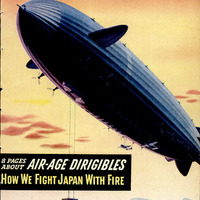 Popular Science Monthly, v. 146, n. 5, 1945
Popular Science Monthly, v. 146, n. 5, 1945

